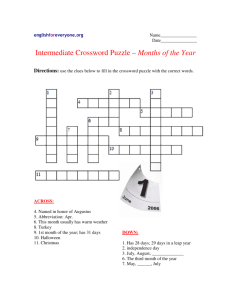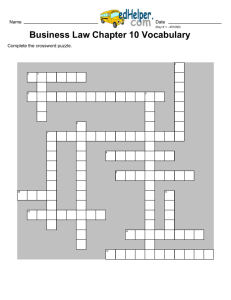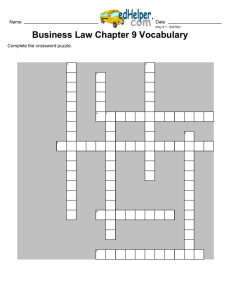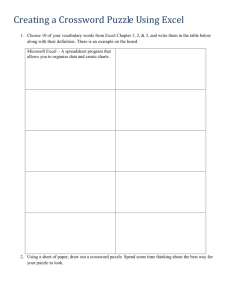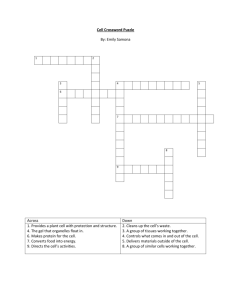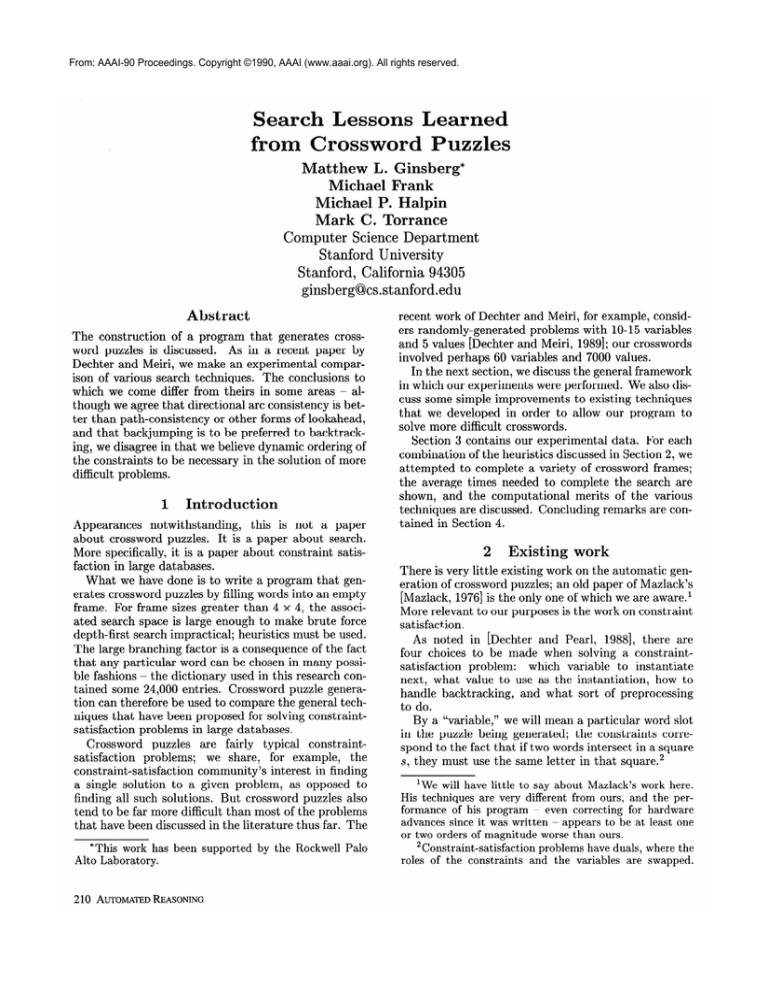
From: AAAI-90 Proceedings. Copyright ©1990, AAAI (www.aaai.org). All rights reserved.
Search Lessons Learned
fro
Crossword Puzzles
Matthew L. Ginsberg*
Michael Frank
Michael P. Halpin
Mark C. Torrance
Computer Science Department
Stanford University
Stanford, California 94305
ginsberg@cs.stanford.edu
Abstract
The construction of a program that generates crossword puzzles is discussed. As in a recent paper by
Dechter and Meiri, we make an experimental comparison of various search techniques. The conclusions to
which we come differ from theirs in some areas - although we agree that directional arc consistency is better than path-consistency or other forms of lookahead,
and that backjumping is to be preferred to backtracking, we disagree in that we believe dynamic ordering of
the constraints to be necessary in the solution of more
difficult problems.
1
Introduction
Appearances notwithstanding,
this is not a paper
about crossword puzzles. It is a paper about search.
More specifically, it is a paper about constraint satisfaction in large databases.
What we have done is to write a program that generates crossword puzzles by filling words into an empty
frame. For frame sizes greater than 4 x 4, the associated search space is large enough to make brute force
depth-first search impractical; heuristics must be used.
The large branching factor is a consequence of the fact
that any particular word can be chosen in many possible fashions - the dictionary used in this research contained some 24,000 entries. Crossword puzzle generation can therefore be used to compare the general techniques that have been proposed for solving constraintsatisfaction problems in large databases.
Crossword puzzles are fairly typical constraintsatisfaction problems; we share, for example, the
constraint-satisfaction
community’s interest in finding
a single solution to a given problem, as opposed to
finding all such solutions. But crossword puzzles also
tend to be far more difficult than most of the problems
that have been discussed in the literature thus far. The
*This work has been supported by the Rockwell Palo
Alto Laboratory.
210 AUTOMATEDREASONING
recent work of Dechter and Meiri, for example, considers randomly-generated problems with lo-15 variables
and 5 values [Dechter and Meiri, 19891; our crosswords
involved perhaps 60 variables and 7000 values.
In the next section, we discuss the general framework
in which our experiments were performed. We also discuss some simple improvements to existing techniques
that we developed in order to allow our program to
solve more difficult crosswords.
Section 3 contains our experimental data. For each
combination of the heuristics discussed in Section 2, we
attempted to complete a variety of crossword frames;
the average times needed to complete the search are
shown, and the computational merits of the various
techniques are discussed. Concluding remarks are contained in Section 4.
2
Existing
work
There is very little existing work on the automatic generation of crossword puzzles; an old paper of Mazlack’s
[Mazlack, 19761 is the only one of which we are aware.’
More relevant to our purposes is the work on constraint
satisfaction.
As noted in [Dechter and Pearl, 19881, there are
four choices to be made when solving a constraintsat isfact ion problem:
which variable to instantiate
next, what value to use as the instantiation, how to
handle backtracking, and what sort of preprocessing
to do.
By a “variable,” we will mean a particular word slot
in the puzzle being generated; the constraints correspond to the fact that if two words intersect in a square
s, they must use the same letter in that square.2
‘We will have little to say about Mazlack’s work here.
His techniques are very different from ours, and the performance of his program - even correcting for hardware
advances since it was written - appears to be at least one
or two orders of magnitude worse than ours.
2Constraint-satisfaction problems have duals, where the
roles of the constraints and the variables are swapped.
Choice
of variable
When choosing which variable to instantiate next (i.e.,
which word to fill in), one must decide whether the
choice should be made when the puzzle is first examined (at “compile time” ) or whether it should be made
dynamically as the other variables are assigned values
(at “run time”).
A variety of compile time heuristics have been discussed elsewhere in the literature.
The so-called
“cheapest-first heuristic” suggests constructing a statistical estimate of the number of choices remaining for
each variable, and to then instantiate the variable that
is the most constrained.3 The “connectivity heuristic”
suggests instantiating a variable that is constrained by
the last variable instantiated, in order to ensure that
one backtracks effectively when a dead end is reached.*
The best-known run time heuristic is known as “dynamic search rearrangement” and suggests that at any
particular point in the search one should pick the variable that actually is the most constrained (by counting
the number of possible solutions for each uninstantiated variable), instead of simply the one that is statistically expected to be the most sharply restricted as in
the cheapest-first heuristic.
The two techniques that we chose to consider were
the cheapest-first heuristic and its run time analog,
dynamic search rearrangement. Connectivity was not
considered because, as noted by Dechter and Meiri in
[Dechter and Meiri, 19891, many of its advantages can
be obtained by using backjumping [Gaschnig, 19791 instead of simple backtracking.
Choice
of instant iat ion
Suppose, then, that we have selected a variable (i.e.,
word) to be filled next. How do we select among the
possible values for it ? In doing so, it is important to
select one that restricts the possible choices for subsequent variables as little as possible. Why use a word
with a Q when one with an S could be used inste’ad?
In crossword puzzles, it is impractical to use this idea
exactly; there are simply too many possible choices for
each variable. Instead, we did the following: Suppose
that we have decided to instantiate some particular
As Rich Korf has pointed out, the dual problem in the
crossword-puzzle domain is also a natural one - the variables are the letters in the puzzle, and the constraints come
from the fact that each letter sequence must be a legal English word.
3For example, if there are 2139 4-letter words in the
dictionary, it is assumed that 2139/26 choices remain after
the second letter is filled in. This is independent of whether
the choice is E (in which case 281 completions remain) or Q
(in which case there is in fact only 1).
4Thus having filled in one word, we would next fill a
word that intersects it. By not jumping from one section
of the puzzle to another, we ensure that chronological backtrack always considers a difficulty related to the one that
actually caused the backup.
word in the puzzle. The
program considers the first k words that can legally fill
this slot; suppose that we denote them by wl,. . . , wk.
For each wi , the number of possibilities for each unfilled
crossing word is computed, and the product of all of
these values is calculated. The word actually chosen is
that wi that maximizes this product.
Of course, the behavior of this heuristic will be sensitive to the choice made for Ic. If k = 1, the first
available word will be used at all times. But making k
too large is also a mistake - all we really need to do is
to make it large enough that one of the first k words
is a fairly good choice. The time spent examining the
rest of the possible words is unlikely to be justified by
the small impact on the size of the subsequent search
space. Some experimentation indicated that Ic = 10
was a reasonable value, and this is the value used in
Section 3, where it is compared with the choice k = 1.
The parameter k was called min-look in the implementation and this is how we will refer to it in Section
3.
variable by filling a particular
Backtracking
When a dead end is reached (i.e., some slot is found
for which there is no legal word), the program needs to
backtrack and try something else. Simple chronological
backtracking (backtrack to the last choice point, as in
PROLOG) suffers from the problem that it may fail to
address the source of the difficulty. If the program is
having trouble filling the upper-left-hand corner of the
puzzle, it is a mistake to make changes in a portion
of the puzzle that have no effect on this problematic
region.
This difficulty can be ovnrcome using a technique
known as backjumping [Gaschnig, 19791, which actually backs up to the source of the difficulty. It has been
shown both theoretically [Dechter, 19901 and experimentally [Dechter and Meiri, 19891 that backjumping
outperforms its chronological counterpart.
If no lookahead is done, backjumping can be implemented simply by always backtracking to a word that
intersects a word that cannot be filled satisfactorily;
the connection with the connectivity heuristic is clear
in this case. If lookahead information is used as well
(see the next section), then backjumping requires us to
maintain, for each instantiated variable, a list of those
subsequent variables that it affects in some way. This
idea is obviously closely related to dependency-directed
backtracking [Stallman and Sussman, 19771, although
it is not quite the same because the expense of maintaining complete dependency information is avoided.
We also considered a small further improvement.
Suppose that we have reached a dead end, and have decided to backjump to a particular word, wi, that is the
source of the difficulty. It is not too hard to determine
what letter or letters in wi are causing the problem,
and to then ensure that the new choice for wi avoids
it. In conventional constraint-propagation
terms, we
GINSBERGETAL.
211
Figure
1: Is multiple
lookahead
worthwhile?
realize that the variable wr is causing trouble because
of the constraints
it places on a subsequent
variable
w2 (or perhaps a collection of subsequent
variables).
Having done so, we make sure that the new choice for
wr allows us to change our selection for 202.
In Section 3, we will refer to the possible choices
as “bt” (simple backtrack),
“bj” (backjump
to the
relevant problem, but make no effort to ensure that
the difficulty has been addressed)
and “sbj” (smart
backjump,
ensuring that some relevant letter changes
value).
Preprocessing
Finally, there is the possibility
of preprocessing
the
data in some way that will reduce the need to backtrack in the first place. In [Dechter and Meiri, 19891,
Dechter and Meiri suggest that the most effective way
to do this is to.preprocess
the information at each node
of the constraint graph in a way that ensures that when
a particular variable w is instantiated,
there will always
be an instantiation
for every other variable that shares
a constraint with w. In terms of crossword puzzles, we
make sure that the choice made for one word is consistent with the choices that will need to be made for
the words that intersect it. This is called directional
arc-consistency
[Dechter and Pearl, 19881.
There are other possibilities
as well. If we think
of directional arc-consistency
as a simple lookahead to
depth 1, directional
path-consistency
is lookahead to
depth 2, so that for the word being instantiated
and
every choice for a word w’ that meets it, there will be
a choice for every word that meets w or w’.
In a crossword puzzle, it is impractical
to store all
of this consistency
information;
there are simply too
many possibilities.
Indeed, this was already observed
by Dechter and Meiri on the simple problems they investigate in [Dechter and Meiri, 19891.
It is possible,
however, to repeat the analysis at
run time, essentially doing a lookahead to a depth of
greater than one when each variable is instantiated.
It seems at first that this should be a good idea.
Consider the puzzle in Figure 1, for example. It might
be the case that there are no two five letter words wr
and w2 such that wr ends in Y, w2 has T as its fourth
letter, and the last letter of w2 is the same as the first
letter of wi. A two-level lookahead would notice this,
212
AUTOMATEDREASONING
04
Figure
2: Test puzzles
and one of the two words in Figure 1 would be withdrawn immediately.
In practice, this does not work so well. The reason is
that the computation
involved is a fairly difficult one we need to look at the possible choices for wi, check
to see which letters are still possible in which spaces
(this is the expensive part, since it involves examining
each of the choices for wi ) , and then to use this information to prune the set of possibilities for ~2. The
analysis is expensive enough that the cost incurred is
not in general recovered by the associated pruning of
More conventionally
put, the forthe search space.
ward branching factor for the problem is high enough
that additional levels of lookahead draw conclusions no
more effectively than their backward counterparts.
3
Frames
Experimental
results
used and raw data
In order to evaluate the usefulness of the ideas in the
last section, the four puzzles appearing in Figures 2
and 3 were solved by the program.
The program always used one level of lookahead (i.e., arc-consistency)
and some form of the cheapest-first
heuristic, since it
was quickly discovered that without these, all but the
simplest puzzles were intractable.
The other parameters were set as follows:
cheapest-first
could be either stat,
indicating
that a compile-time
statistical
approximation
was
used, or exact, indicating that the exact (run-time)
value was used.
If the run-time ordering were used, min-look
could
be either 1 (always use the first acceptable word) or
10 (use the best choice among the first ten acceptable
words).
This calculation
was not performed when
the statistical ordering was used, since only dynamic
information about variable orderings can be used to
distinguish among words in this fashion.
connected-backtrack
could be either bt, bj or sbj,
as described in the previous section.
For each allowable selection of parameters,
each of
the above puzzles was solved 10 times; the dictionary
was shuffled between each solution attempt to ensure
that the performance
of the program was not affected
by a particularly
fortunate
or unfortunate
choice of
word at any point.
The results are as reported in Figure 4; the times
reported are in seconds for a Symbolics 3620 with 2
megawords of memory. We feel that time of solution is
a more valuable gauge of performance
than the number of nodes examined or the number of backtracks
(as used in [Dechter and Meiri, 19891) because it is often possible to prune the search space but only at a
prohibitive cost in terms of the time spent expanding
This is the argument we made when
a single node.
considering lookahead to multiple depths.
For the harder puzzles, many of the choices of parameters did not lead to solutions being found within
20 minutes of CPU time, and no timing information is
reported for these parameter choices. The most difficult puzzle ((d) in Figure 3) was solved in only 8 of 10
cases with min-look
set to 1.
Analysis
As already mentioned, arc-consistency
and cheapestfirst were needed to solve any of the puzzles.
With
regard to the other choices, we observed the following:
(4
Figure
3: Test puzzles (ctd.)
Choice of variable Unlike the results reported by
Dechter and Meiri in [Dechter and Meiri, 19891, it is
apparent even for the 5 x 5 puzzle that runtime information plays an important role in the choice of word
to be filled next.
The difference in performance
between the programs that used an exact version of the
cheapest-first
heuristic and those that used the statistical approximation
available at compile time is significant in all cases; the two most difficult puzzles could
not be solved at all within the twenty minute time limit
unless runtime information was used.
GINSBERG
ET AL. 213
The overhead involved in
Choice of instantiation
finding a word that minimally restricts the subsequent
search is worthwhile only on puzzles of size 9 x 9 and
larger, and it is not until the most difficult of the four
puzzles is considered that this heuristic begins to play
a significant role. This suggests that the choice of
min-look (the number of words considered to fill a particular slot) should be closely coupled to the apparent
difficulty of the puzzle being constructed.
Backtrack
Backjumping
(as opposed to simple
backtracking) is another heuristic the value of which
is only apparent on the larger puzzles; on smaller ones,
the cheapest-first heuristic tends to order the words
in a way that results in a particular word intersecting
the word being filled next and the two techniques coincide. “Smart” backjumping is needed for puzzle (d)
only - but here, it turned out to be absolutely crucial. The reason is that many of the 13-letter words
have endings like “tion” and if this choice made the
upper-right hand corner of the puzzle impossible to
fill, it was important not to try another word with the
same ending. Of course, it is not clear to what extent
other constraint-satisfaction problems will share these
features, but it is not unreasonable to think that they
will.
Things that didn’t work
It is also probably worthwhile to report on search
heuristics that we tried, but that didn’t reduce the time
needed to find a solution to the puzzle.
Tree reordering while backtracking
Suppose
that backjurnping has caused us to backtrack over a
word w because it was not relevant to the problem
that caused the backtrack in the first place. Is it reasonable to put w back into the puzzle before resuming
the search, thereby modifying the order in which the
search is conducted so that we can reuse the information that would otherwise be lost?
Unfortunately not. Just because removing w doesn’t
directly alleviate a particular difficulty is no reason to
believe that keeping w won’t commit us to the same
problem. As an example, suppose that we put in a
word 201, then a crossword ~2, then discover that another crossword ws to wr cannot be filled satisfactorily.
Provided that the choices for ws are not constrained
by the selection of wz, we will backtrack directly to wi,
and the above suggestion would therefore cause us to
replace w2 in the puzzle. Unfortunately, this replacement might well commit us to wi once again.
It may be possible to identify a limited set of situations where words that are passed over during backtracking can be safely replaced, but these situations
appear to be fairly rare in practice and the cost of
searching for them seems not to be justified.
214 AUTOMATEDREASONING
Compile-time dictionary ordering We also considered the possibility of ordering the dictionary not
randomly, but in a way that would prefer the use of
words containing common letters.
For small puzzles, this led to significant performance
improvements; the preference of common letters virtually eliminated the need to backtrack on puzzles (a)
and (b). On puzzle (c), however, the performance gain
was much more modest (perhaps 20%), while on puzzle (d), the performance appeared to actually worsen
- the program was no longer able to solve the puzzle
within the twenty minute time limit if min-look was
set to 10. (For min-look set to 1, however, only 15
seconds were required.)
It is difficult to know what to make of such conflicting data; since the ordered dictionary can no longer be
shuffled to eliminate statistical fluctuations in solution
time, it is possible that the observed behavior is not reflecting the fundamental nature of the algorithm. The
best explanation we can offer is the following one:
On large puzzles, where backtracking is inevitable,
the ordered dictionary is likely to result in the first
ten choices for any particular word being fairly similar. As a result, the program might just as well select
the first word as any of the first ten; in fact, the time
spent considering the others is unlikely to be repaid in
practice. This is consistent with the observed behavior - the performance for an ordered dictionary with
min-look set to 1 was uniformly better than if this parameter were set to 10. We feel this to be undesirable
for the following reasons:
The performance of the program becomes quite brittle. If lucky, it will solve a puzzle very quickly; if unlucky, it may not solve it at all. This is the behavior
that was observed on puzzle (d).
The program cannot improve its performance on
very difficult puzzles by increasing the value of
min-look, since this technique has been essentially
invalidated by the diet ionary ordering.
In addition, further experimentation showed that it
was not possible to avoid this problem by segmenting
the dictionary or ordering it in any other way (such
as maximizing the letter differences between words appearing near each other).
We wish that we could make more definitive remarks
about this technique, but cannot.
4
Conclusion
Summarizing, the conclusions that we have drawn from
the experimental data. in Figure 4 are the following:
1. Arc-consistency is needed if difficult constraintsatisfaction problems are to be solved effectively.
2. It is far more efficient to order variables at run time
than to use the statistical information available at
compile time.
3. It is important to select the instantiation for each
variable carefully, although not so important that
every choice should be considered in large domains.
4. Backjumping is to be preferred to simple backtrack-
ing. In addition, it is important to ensure that subsequent labels for a particular variable actually address
a difficulty that was found previously in the search;
this can be done without incurring the prohibitive
costs involved in maintaining complete dependency
information when the tree is expanded.
Acknowledgement
The first author is indebted to Greg Arnold, David
Smith, Phil Stubblefield, Rich Washington and the students of his introductory artificial intelligence class for
many enlightening discussions. The comments of Rich
Korf and one other anonymous referee were also helpful.
References
[Dechter, 19901 R ina Dechter. Enhancement schemes
for constraint processing: backjumping, learning,
and cutset decomposition. Artificial Intelligence,
1990. To appear.
[Dechter and Meiri, 19891 Rina
Dechter and Itay Meiri. Experimental evaluation
of preprocessing techniques in constraint satisfaction problems. In Proceedings of the Eleventh International Joint Conference
gence, pages 271-277,
1989.
on Artificial
InteZZi-
[Dechter and Pearl, 19881 Rina Dechter and Judea
Pearl. Network-based heuristics for constraintArtificial
Intelligence,
sat isfact ion problems.
34:1-38, 1988.
[Gas&rig,
19791 John Gaschnig.
surement
gorithms.
and
Analysis
of
Puzzle
I/Cheapest I
first
min-look
Backtrack
(set)
1
(4
exact
exact
exact
exact
exact
1
10
10
_
bt
bj
sbj
sbj
bt
sbj
10
bj
0.505
0.533
0.605
0.607
0.612
0.693
0.719
1.015
1.041
(b)
(4
Performance
MeaCertain
Search AZ-
Technical Report CMU-CS-79-124,
Carnegie-Mellon University, 1979.
[Mazlack, 19761 L awrence J. Mazlack. Computer construction of crossword puzzles using precedence
relationships. Artificial Intelligence, 7:1--19, 1976.
(4
stat
exact
stat
stat
Time
1
bj
bt
exact
exact
exact
exact
exact
exact
stat
stat
stat
10
10
10
exact
exact
exact
exact
10
10
sbj
1
sbj
exact
exact
1
1
-
_
_
bt
sbj
bj
sbj
bt
bj
sbj
bj
bt
bj
bj
2.363
2.453
2.497
4.967
6.327
6.587
17.022
17.170
31.526
11.904
15.539
17.668
17.798
10
sbj
71.693
1
sbj
4oEA555*
* Completed on only 8 of 10 attempts
Figure 4: Test results; techniques not listed were not
able to solve the puzzles in question
[Stallman and Sussman, 19771 R. M. Stallman and
G. J. Sussman.
Forward reasoning and
dependency-directed backtracking in a system for
computer-aided circuit analysis. Artificial InteZZigence, 9(2):135-196, 1977.
GINSBERGETAL.
215

